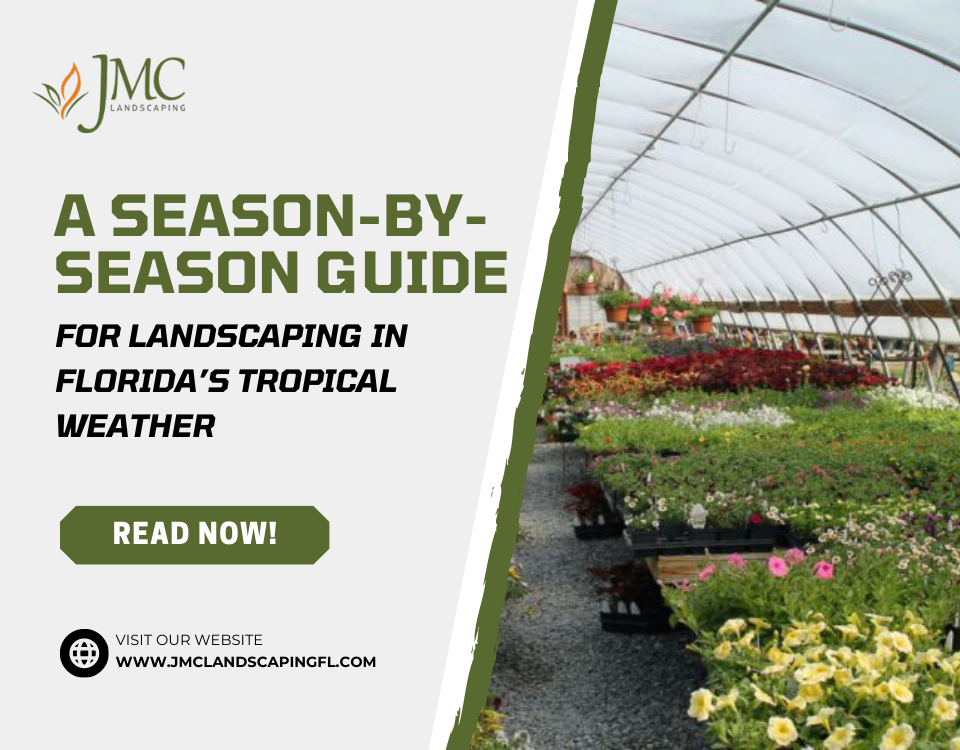Landscaping in Florida is simple if you follow some simple guidelines. That’s because our lovely climate allows for growth in all four seasons. The outside of your home may be as attractive as the inside with a little forethought and some basic techniques. We will teach you how in this detailed, season-by-season, guide.
Choosing the appropriate plants for our tropical climate
If you began gardening in a cooler climate, you might not be familiar with the wonderful range of plants that grow. Many native plants flourish in Florida, and many more may survive with a little more care such as
- Areca Palm
- Coconut Palm
- Juniper Shrub
- Hibiscus (different varieties include Presiden Red, Tequila, Fiesta, Peach, and White)
- Bougainvillea (Dwarf, and climbing varieties)
- And many more
Consider positioning when planting a garden or selecting trees for your home. You will need to place larger tree varieties farther from your home. A garden must have at least six hours of direct sunlight and be located near a water source. Consider the aesthetics and sun conditions when placing ornamentals and flowers.
If you grow drought-tolerant plants, they will survive better throughout the dry season. Native flora has adapted to flourish in the particular environment of Pine Island, Florida. Choosing the proper plants can help you save time and money while still enjoying the benefits of a beautiful yard. Plants that attract butterflies, hummingbirds, and other pollinators can benefit both you and the environment.
Florida Fall Landscaping
Fall in Florida is still warm, but it’s a good time to transition from heat-hearty plants to more delicate varieties. This is the period of the year when Florida transitions from the rainy season to the dry season.
Remember the following fall gardening tips:
Pruning: Although trees don’t tend to lose all their leaves in central Florida, it’s a good idea to skip pruning during this season. You should prune most trees in late winter or early spring, and this rule stays true in Florida.
Flower bed: Now is an excellent opportunity to prepare and beautify your flower beds. By planting annuals and bulbs that thrive in slightly lower temperatures, you can have gorgeous colours well into the new year. Don’t forget to divide and replant your perennials. You must allow them sufficient time to reestablish themselves before the onset of cold snaps.
Irrigation: As the weather cools, your plants will require less extra water.
Fertilization: October is an excellent time to fertilize your grass. The typical, everyday rainstorms have passed, so the fertilizer will not be washed into the waterways, where it might harm plants and animals. It will remain on your lawn and garden as desired. Additionally, this is a good time to fertilize citrus trees.
Prepare for Chilly Weather with the Following Tips:
January is the time to prune non-spring flowering trees and shrubs. January is also an ideal season to trim deciduous fruit trees, such as peach, plum, and Asian pear.
In the early months of the year, prune roses. After pruning shrubs and roses, the beds should be fertilized and mulched. The new layer of mulch will aid in retaining moisture and keeping the fertilizer in place.
Plant annuals that can withstand cold weather in your flower beds. This category contains pansies, snapdragons, and petunias. The winter months are ideal for establishing bulbous blooms such as amaryllis. When planting bulbs outdoors, be sure to shield them from extreme temperatures with a layer of mulch. The bulbs will require routine watering to establish themselves.
Palms: Cold weather can cause harm to palms. After any frosts or sudden temperature decreases, observe your palm trees closely. If you find dead branches or leaf tissue, treat them for frost damage.
Open the Door to the Great Outdoors in Spring
Spring is a good time to work on your landscape outdoors. It is not yet very hot, but it is warm enough for many plants to bloom during this period. Now is a good time to inspect your irrigation system. Ensure that it is in proper operating order for the next dry and warmer months.
This time of year inspires numerous individuals to initiate new gardening projects. If you fall into this category, consider the following:
After azaleas have completed flowering, prune them immediately. The moment has come to form azaleas. When pruning flowering shrubs or flowering trees, prune after the last blooms have faded but before the new buds form. This ensures a well-shaped tree or shrub and prevents you from destroying next year’s flower buds.
In flower beds, remove any annuals that have died during the winter and replace them with kinds that will bloom throughout the warmer months. Plant bulbs like caladiums. Caladiums will flourish over the spring and summer months. Consider planting daylilies, which are available in early-, mid-, and late-blooming types to ensure blooms for months.
As the warmer months approach, it is vital to evaluate the location of your flower plantings. Remember to search for plants that will thrive in particular regions of your yard. Some plants flourish in direct sunlight, while others require more shade.
Consider incorporating a pollinator area into your garden now. A pollinator garden encourages the presence of pollinators such as bees, hummingbirds, and butterflies. Planting native Floridian plants is an excellent approach to eliminating the need for fertilizers and excessive irrigation. It also provides much-needed habitat for native species. Pollinator gardens are an aesthetically pleasing addition to any landscape. You can obtain additional information by contacting the Florida Native Plant Society.
Plant herbs that thrive in warm conditions, such as rosemary and basil. Herbs are an excellent addition to a garden. In addition to being delicious when used at home, they also attract butterflies. The plants are also beautiful and frequently decorative.
Keep an eye out for indications that your plants need water. Mulching can aid in weed suppression and moisture retention.
The Summer Heat Does Not Have to Force You Indoors.
Summer is characterized by hot temperatures and heavy rainfall. Summer gardening requires attention and persistence. Always consider plant arrangement and variety.
Follow these simple ways to keep your yard beautiful over the long summer days if the heat becomes unbearable:
Flower beds: In the summer, flowers that thrive in hot temperatures, such as coleus and ornamental peppers, will flourish. Plant gladiolus till approximately mid-summer. Throughout the summer, lilies such as spiders, Aztecs, and butterflies can be planted.
Another alternative is to clean your garden and attempt solarization. This method can rid the soil of undesirable weeds, nematodes, illnesses, and insects. The tilled soil is covered with transparent plastic, which transfers heat into the topsoil. If solarization is effective, the accumulating heat can kill diseases and insects.
Ensure that your irrigation systems are functioning properly and are not leaking. Consider adding a sensor that will shut off sprinklers and irrigation when it rains.
Palms: The summer months are ideal for planting palms. This allows them time to establish themselves prior to the onset of winter weather. Keep lawn fertilizers away from the root system and do not cover the trunk with the earth. Examine elder fronds for signs of yellowing. This may indicate a magnesium or potassium deficit.
We hope you like this seasonal guide on how to take care of your landscaping and the plants it consists of. For more details, contact JMC Landscaping in Florida now at 239 558 5943!







Leave a Comment